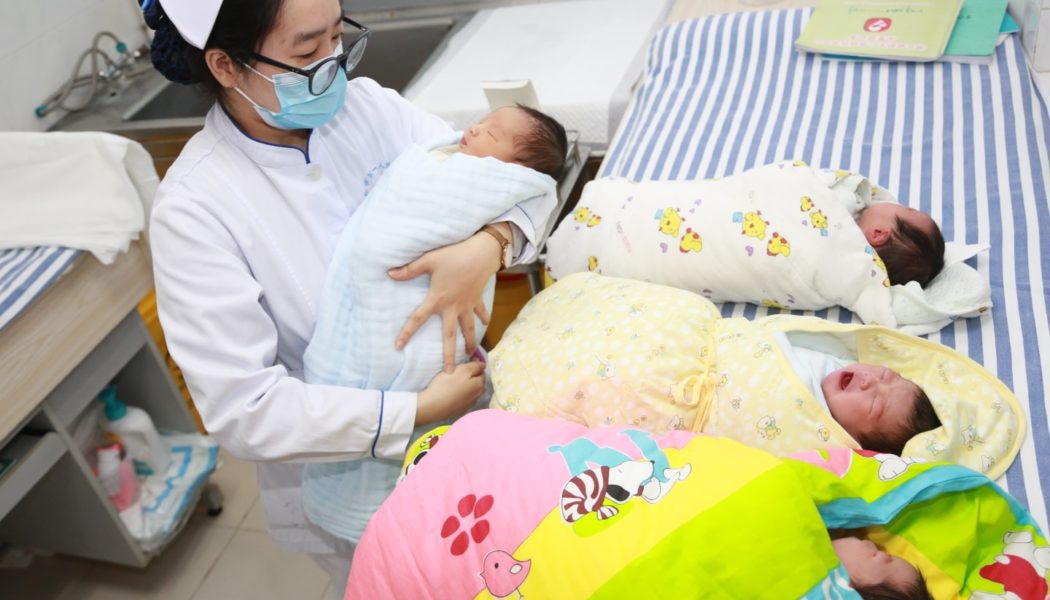Liu Yan is a mother of one in Beijing. Her days are packed between working at an internet services company and caring for her 6-year-old daughter. In 2016, the Chinese government abandoned its decadeslong one-child policy and started allowing families to have two children. For Liu — who asked that we not use her real name — the policy change didn’t inspire her to add another member to her family.
Hear more from Lili Pike about this story:
“I already feel so exhausted raising our kid,” Liu, who is the primary caretaker, told Grid, “so I don’t want to start all over again taking care of a second child.” Beyond feeling drained, she is also worried about her family’s finances. Even though her daughter is still young, Liu says she has already felt pressure, in China’s hypercompetitive environment, to arrange prep classes and extracurricular activities. “If you don’t sign your child up for classes, you feel like maybe you’re not doing enough for them,” she said.
Liu’s feelings are mirrored by women across China. National statistics show that even after the change in policy, couples still prefer to have one child. In 2020, the birthrate continued a yearslong decline to just 1.3 children per woman, well below the “replacement rate” of 2.1, and the lowest rate in China since at least 1950.
The current trends add up to a monumental turning point for a country whose population — its young workforce in particular — helped power an unprecedented economic rise. Based on preliminary data, some Chinese demographers say that China’s population may have begun to fall in 2021. After peaking, the population will decline — significantly, by some projections. A 2020 study published in the Lancet estimated that China’s population could be cut in half by 2100.
As China has approached this precipice, the Communist Party has grown increasingly alarmed. Last May, the government announced it would start not only allowing but encouraging families to have three children, another dramatic shift from the old family-planning rules. In November, a commentary published by a state-affiliated media outlet argued that the country’s 95 million Communist Party members should follow the state’s exhortations and start having more children themselves: “Every CCP member should shoulder the responsibility and obligation of the country’s population growth and act on the three-child policy.” The post went viral and elicited widespread opposition from online commentators, according to the South China Morning Post.
It’s unclear just how serious the demography problem will prove for China, but experts agree that the situation presents profound challenges for the economy, from a shrinking workforce to a swelling group of elderly citizens who will need pensions and healthcare.
“People vastly overlook the level of domestic challenge China is going to confront,” Carl Minzner, a professor at Fordham University Law School who focuses on Chinese governance, told a September panel at the National Committee on U.S.-China Relations. “You just have to look at some of the other developed East Asian countries to realize exactly how severe the challenge is once your society rapidly ages.”
What’s driving China’s demographic transition
This demographic turning point has been decades in the making. China has been following a well-established global trend: As countries become wealthier and female education rises, birthrates fall. Wealthier Asian countries, most notably South Korea — which has the world’s lowest birthrate — have been prime examples.
In China’s case, the change was accelerated by one of the largest social engineering efforts in history. Introduced in 1979, the one-child policy was a poverty-fighting and economic growth policy, and it was broadly and rigorously enforced. Scholars have debated how much the policy contributed to the decline in China’s birthrate, but it certainly had an effect. The policy not only led to millions of one-child families, it also resulted in a greater gender imbalance as women had sex-selective abortions, and families even abandoned or killed female babies. So today there are also fewer would-be mothers than there would have been absent the one-child policy.
ADVERTISEMENT
When the Communist Party began allowing families to have two children in 2016, the news made headlines worldwide. But in China itself, the change led to more of a baby blip than boom. The birthrate increased briefly in 2016 before dropping again, and the new three-child policy seems unlikely to change things. While the one-child restriction held back couples, broader social trends have changed behavior — perhaps irrevocably.
Surveys reveal some of the reasons behind the decline. To begin with, fewer young people, particularly women, even want to get married. In a recent survey of urban Gen Zers conducted by a research institute affiliated with the Communist Youth League, 44 percent of women said they either didn’t want to get married or weren’t sure if they would. The men and women surveyed cited difficulty finding the right partner and a lack of time and energy as reasons for not wanting to marry.
Meanwhile, many married couples are choosing not to have kids for the same financial reasons that worry Liu. In a survey conducted by the China Youth Daily, millennials cited a lack of child care options and financial pressures as their top reasons for not having a second child.
:quality(100)/cloudfront-us-east-1.images.arcpublishing.com/thesummit/J5CBUO7MIJHINIQQ7F3DU2FFBA.jpg)
To better understand how women in China choose whether or not to have children, Ye Liu, a sociologist at King’s College London, has been running a study on the lives of 82 urban women born in the 1980s. She said many of those women found the three-child policy laughable: “If the two-child policy had any kind of, you know, rationale behind it, the three-child policy was just a joke to them.”
Why? For many of the women Ye interviewed, professional repercussions were top of mind. “Even if they got a good job, they face sexist and misogynist subcultures on a daily basis,” Ye told Grid, “and particularly when they got married, they faced moments of discussing their fertility plan with their line manager, and they were even asked in interviews [about it].” When women in her study were pregnant, Ye said, many had projects taken from them because they were deemed by their bosses to have “diminished capabilities.” In one case, a woman was demoted upon returning from maternity leave. There are no easy remedies in China for such treatment. For these women, having an additional child could mean further career setbacks.
ADVERTISEMENT
As Ye said, “Generally speaking, they are still penalized for being a mother, for being pregnant.”
And it’s not just the urban elite who are reluctant to have more children. In rural China, too, couples are choosing to have fewer children due to rising costs. Huang Wenzheng, a Chinese demographer, told the South China Morning Post that a higher rural birthrate used to compensate for lower rates in cities, but that is no longer the case.
From the “world’s factory” to a shrinking workforce
For Chinese families, having only one child may feel like the best decision, given all these social pressures and their own preferences. But for the Chinese government, the impending population drop is leading to a tangled web of economic problems.
A key concern is the size of China’s workforce, the juggernaut that helped propel the country’s remarkable, three-decade rise from poverty to global economic powerhouse. In recent years, that demographic tail wind has turned into a drag. According to a 2019 study, the aging of China’s population since 2000 has slightly slowed economic growth. And as the population shrinks and ages going forward, the economic impacts loom large.
The number of working-age people has actually been dropping since 2012, and as China’s population ages further, the decline will only accelerate. By 2050, the working-age group is projected to drop by 17 percent — an eye-popping 174 million people lost from the workforce — according to an estimate by the U.N. population division. The true figure may be even higher; some demographers say the U.N. scenario overstates the future fertility rate.
ADVERTISEMENT
And as the number of workers drops, the number of dependents — children and the elderly, who contribute far less to the economy — will rise. The Chinese government is planning to raise the retirement age to expand the labor pool, but that move has been delayed by public opposition. And while some countries have relied on immigration to compensate for an aging workforce, the number of permanent foreign residents in China remains very low.
“Obviously, to what extent the demographic challenges will become a drag on growth depends on China’s own policy choices,” said Tianlei Huang, a research fellow at the Peterson Institute for International Economics. “There is no denying that what is in front of the Chinese policymakers is a very tough situation.”
A heavy burden for the state
The economic fallout of the demographic turning point looms as a critical issue for the party, particularly given the ambitious agenda President Xi Jinping and the party leadership have set forth. Xi has set a target of doubling the economy from 2020 to 2035, which would require a 4.7 percent annual GDP growth rate. In the short term, the lingering pandemic and China’s “zero-covid” approach are obstacles; the population numbers are a serious concern for the long term.
“The key to the Chinese Dream and China’s regime is economic development and its global ambitions,” said Ye. “The demographic crisis holds China’s economy back, and holds its global ambition back, so it’s definitely a real concern for the top leadership.”
A core part of that challenge will involve the elderly — and the job of dramatically reorienting social services to provide for an older China. The U.N. projects that the percentage of the Chinese population over 65 will increase from 12 percent in 2020 to 26 percent in 2050.
ADVERTISEMENT
As Wang Feng, a sociologist at the University of California, Irvine, wrote in a 2018 study, “while the broad macroeconomic implications of population aging are debated, the narrow fiscal implications are more straightforward.”
Wang and his co-authors forecast a sharp rise in the share of China’s GDP spent on education, health and pensions from 10 percent in 2014 to 15 percent in 2030, and 20 percent by 2050 — and that assumed no increase in benefits.
The study estimates that pension spending alone could burn up half the government’s revenue by midcentury. To meet the rising demand, the government will have to raise taxes, Wang said, particularly property taxes — something the party has been kicking down the road for years.
“Providing these kinds of safety nets, and social benefits, is at the core of their political legitimacy,” said Wang. But raising property taxes is “highly explosive politically.”
A wake-up call for gender equality?
There may be no turning back the demographic trends, but the government remains hopeful that new policies may boost the birthrate now and improve China’s fortunes in the decades to come.
ADVERTISEMENT
In a May 2021 essay, Chinese feminist activist Lü Pin argued that the government needs to do much more to end discrimination against women in the workplace and uphold women’s rights more broadly.
In recent months, along with the arrival of the three-child policy, local and national governments have started implementing such reforms. In December, the National People’s Congress began reviewing an amendment to China’s foundational women’s rights law. The change would make much of the workplace discrimination Ye’s subjects described illegal. For instance, employers would no longer be able to ask female employees about their marriage or family plans, and firing women or cutting their pay after maternity leave would be outlawed.
In addition, Shanghai, Beijing and several provinces have increased maternity leave. Nationally, women are allowed to take 98 days of maternity leave, and Beijing and Zhejiang province have added an extra 60 days on top of that. The party is also trying to reduce the costs of raising children. By 2025, it aims to increase the number of day care centers by 150 percent and boost the number that are subsidized. And last summer, new rules were instituted that largely banned private tutoring, with the idea that it would help level the playing field for lower-income families who can’t afford to pay for extracurricular classes.
Lü and other feminists and scholars argue that while the government can help create supportive conditions for families who want children, that is where the party’s role should end. As Stuart Gietel-Basten, a demographer at the Hong Kong University of Science and Technology, told Grid, “The answer does not lie in pushing women to have more children.”
Leta Hong Fincher, a scholar of Chinese feminism, has documented how the party has adopted what she calls a “pronatalist” stance, even stigmatizing single females heading into their 30s as “leftover women” in a campaign that began in 2007. After the publication of the two-child policy, the People’s Daily, the party’s main mouthpiece, ran a headline that read “Having Children is Not Only a Matter of Individual Families but Also a Matter of the Nation.”
ADVERTISEMENT
Ye believes these heavy-handed tactics reflect a fundamental political problem in China: Only 8 percent of party leadership is female. More female representation in government, she said, could help the party design policies that truly help women at home and in the workplace.
Where the Chinese government doesn’t want more children
It is important to note one glaring exception to the government’s push to grow the population. China has taken the opposite approach when it comes to Uyghur and other minority women in China’s western Xinjiang region. An Associated Press investigation published in 2020 found that the government has subjected hundreds of thousands of women there to forced sterilization, IUD insertions and abortions. The reporters also documented that parents were sent to detention camps for having too many children. In the midst of these campaigns, the birthrate in Xinjiang, which had been higher than the national average, has declined sharply.
The Uyghur Tribunal — an unofficial, independent commission established in the United Kingdom — recently determined that based on evidence of “the imposition of measures to prevent births,” the Chinese government’s actions in Xinjiang amounted to genocide.
:quality(100)/cloudfront-us-east-1.images.arcpublishing.com/thesummit/3ONTOUB3SVASNAYQL2YWAGFSSA.jpg)
Imagining China, circa 2050
Overall, China’s current demographic portrait reflects tensions and conflicts coursing through Chinese society more broadly, from the costs of urban living to workplace stress, from gender discrimination to the state’s repression of Muslim minorities.
Looking forward, demographers inside and outside China believe government officials are right to be worried about a shrinking and aging population, but there may be some silver linings. Or at least a different way to look at the nationwide numbers.
ADVERTISEMENT
What the statistics alone don’t account for is what a pair of Chinese scholars referred to as China’s shift from a “quantity advantage” to a “quality advantage.” In other words, China’s young people today have a huge leg up on workers from previous generations: They are far better educated.
In a recent study, researchers looked at how this education bump could shape China’s future. Accounting for education and employment trends, they found that while the number of dependents in China’s population will rise, the higher education level of the young generation of workers could help compensate for the change.
“There is this view among others that there is going to be this cataclysmic future for China demographically,” said Gietel-Basten, one of the study’s authors. “But it also should be healthier, and it’ll be more highly educated. And if that can be translated into productivity, then it might be able to weather some of these demographic challenges.”
The potential of a younger, more productive cohort is reflected in the party’s economic strategy. The party has recently moved toward promoting high-quality growth, which emphasizes high-value job creation over the low-end manufacturing of the past, rather than simply targeting strong GDP growth. The government has poured state subsidies into supporting domestic research and development and manufacturing in such industries, from electric vehicles to semiconductors.
The success of this strategy will depend in part on young people’s willingness and training to do these jobs. While the government has funneled resources toward vocational schools to prepare them for these trades, some young people, feeling overburdened by the rat race of working life in many sectors, have joined the tang ping, or “lying flat” movement — essentially checking out of fast-paced life for a slower, less ambitious path. In an August 2021 speech, Xi took aim at the tang ping movement, reflecting the party’s concern that young people won’t step into their role as economic growth engines.
From motivating the young workforce to pushing back the retirement age to supporting families who want more children, adjusting to the new demographic reality will be a challenge for the government in the coming years. Having only one child may continue to be preferable for women like Liu Yan, despite the policy changes — no matter how hard the state tries to change that. And that means Chinese society may look very different by 2050.
Join Our Telegram Group : Salvation & Prosperity









